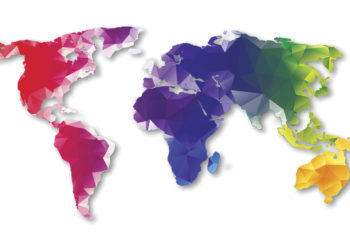Haseeb Irfanullah was on the panel of The Scholarly Kitchen-hosted Society for Scholarly Publishing webinar ‘The Future of Research as a Global Enterprise’ held on April 13, 2022. This post captures some of his thoughts shared at this event.
When we think of research as a global enterprise, it is not only about ensuring open and equitable access to research by all, or overcoming our language or policy differences, or promoting transnational collaborations. There are many other pertinent issues to explore and act on ― in this piece, I focus on four of them.
First, to make research a truly global enterprise, we indeed need to reduce the North-South divide in scholarly publishing ― in terms of publishing standards and practices, technology and infrastructure, research culture, and reach and impact, to name a few. The North has been investing in the South to reduce these gaps, but is it genuinely benefiting the South, sustainably? It seems that the approaches we have been following over the last couple of decades need to be revisited.

Let’s take capacity building of the Southern researchers for research communication as an example. Massive Open Online Courses (MOOCs) on scholarly writing are regularly being organized by different Northern projects for (early-career) researchers of the Low- and Middle-Income Countries (LMICs) or the Least Developed Countries (LDCs). Since 2015, for example, INASP has been organizing the AuthorAID MOOCs on research writing. Through 2021, these saw participation by about 30,000 individuals from all over the Global South — from Guatemala to Uganda to Viet Nam. Launched in 2019, the Research4Life MOOCs are relatively specialized, focusing on the academic communication ecosystem, information literacy, and capacity development and advocacy strategies, and so far were accessed by about 6,800 persons from member institutions.
Given the high participation rates, it could be asked, if it is a cultural thing for the South to take part in free training programs organized by Northern organizations or if there is a genuine need for such capacity development. The high completion rates of the AuthorAID MOOCs (48%) and the Research4Life MOOCs (46%) indicate a real need. As an active contributor to several research writing MOOCs, I have also realized that many researchers participate to learn very fundamental aspects of research communication. That makes me wonder why the early-career researchers’ needs are not being addressed by their fellow experienced researchers/mentors, by their respective host institutions, or by the learned societies of their disciplines? Despite the North’s investment for many years, why is the nature of demand for training from the South not changing much? Why is the South’s research leadership not making concerted effort to lead their own capacity development? Or are they simply handing over the responsibility to the Northern institutions?
We do have fantastic regional initiatives for capacity development (e.g., Training Centre in Communication, TCC Africa), scholarly infrastructure (e.g., AfricArXiv in Africa and SciELO in Latin America), and North-South collaboration to build research capacity (e.g., APN in Asia-Pacific). For research to become a genuinely global enterprise, we need a shift in the responsibilities between the North and the South. We need to focus on investing in creating champions within the Southern research ecosystem who will lead the way to improve their own systems, sustainably.
To improve diversity, equity, inclusion, and accessibility (DEIA) in their publishing systems, Northern journals often invite editorial board members from the South. Subsequently, this creates an opportunity for the respective journals to diversify, at least geographically, their author and reviewer pools. I wonder whether the experience, knowledge, and connections these Southern editors gather by being part of these reputed journals are being put to use to improve the publishing ecosystems of their own countries, which are often lagging in terms of quality, reach, and impact? Publishers from the North must also think about how to harness this opportunity for improving Southern academic publishing. In these ways, the North’s good intention to reduce the North-South divide and related investments will be sustainably impactful.
Second, for research to be a global enterprise, we need to assess the real impact of research. This cannot be accomplished by just measuring how our journals are doing, by calculating impact factors, indices, and scores for an article or how a researcher or our universities are doing — we must instead look into how research is changing policies and practices on the ground. The United Nations Sustainable Development Goal (SDG) Framework 2030 is giving us one such opportunity. But are we tapping it by analyzing how the articles of our journals are advancing the 17 SDGs or their 169 targets and 232 unique indicators?
A couple of attempts have recently been made to develop research assessment tools in relation to the SDGs, both from an academic and a business solution point of views. It may be argued that these tools won’t make any real contribution to finding linkage between research and the SDGs since they boil down research impact into mere numbers and rankings. This will always be a challenge with quantitative tools. We need to further explore qualitative ways to measure research impact, for example, how research is defining our actions against climate change through the Intergovernmental Panel on Climate Change (IPCC)’s assessment reports (I will come back to this example later) or how a country in economic transition ― graduating from least developed to developing status ― is using research to design its prosperity plans.
There is another potential risk of using the SDGs to measure research impact. Many Southern universities are too relatively small to be part of renowned global university rankings. Since 2019, the Impact Rankings by the Times Higher Education (THE) has been giving the universities of the Global South an opportunity to be ranked by their contributions to achieving selected SDGs through research, stewardship, outreach, and teaching. The 2022 edition of this ranking will be announced today, on April 27, 2022, and has considered applications from 1,525 universities, — an increase of almost 25% over last year. However, this pressure of being “ranked” might be shaping the way we write our research by including certain SDG-related terminologies/framings in our articles, so that they get “picked” from Scopus and our universities score sufficient “points”. This may not truly reflect the impact our research is making on the ground — mitigating plastic pollution in our water ways, making our economy resilient to shocks, like pandemics, or changing our school curricula incorporating mental health issues, for example.
My third point starts with a question ― can we really have research as a global enterprise if we don’t take non-peer reviewed research literature or grey literature into account? Recently, the IPCC has made public its 6th Assessment Report on climate change. Every six or eight years, these reports show how the Earth’s climate is being changed by human activities, how it is impacting our socio-ecological systems, how we are adapting to it, what actions are being taken to fight the climate crisis, and what else should be urgently done. These global assessments are the largest of their kind and have been guiding our climate-related decisions since 1990. While preparing these reports, priority is given to peer-reviewed literature, but non-peer reviewed documents are also used with proper justification.
The second volume (February 2022) of the 6th Assessment Report is almost 3,700-pages long and consists of 18 chapters and seven cross-chapter papers written by 330 authors. I have gone through the lists of references of three chapters to calculate the proportions of peer-reviewed and non-peer-reviewed literature. Chapter 1 (the introduction) cites 656 references: peer-reviewed journal articles (74%), book/book chapters (14.5%), and other non-peer-reviewed literature (11.5%). Chapter 2 (a scientific chapter on ecology) includes 2,275 references: peer-reviewed journal articles (93.5%), book/book chapters (4%), and other non-peer-reviewed literature (2.5%). Chapter 8 is on poverty, livelihoods, and sustainable development, thus less technical, and includes 1,067 references: peer-reviewed journal articles (76%), book/book chapters (11%), and other non-peer-reviewed literature (13%). This indicates that less technical/hardcore science-based chapters are written based on around 25% non-peer reviewed literature.
While commenting on one of my Scholarly Kitchen posts, Toby Green of Coherent Digital highlighted the importance of grey literature in our scholarly ecosystem, but also how often it remains ‘invisible’ and gradually becomes obsolete given that it is largely hosted on project-financed websites. Initiatives, such as Policy Commons, are trying to change this scenario by preserving grey scholarly literature. We need more innovative approaches that will appreciate the contributions of grey literature to advancing science.
Finally, scholarly publishers are an integral part of our collective effort to make research truly a global enterprise. But they must respond to global calls beyond industry boundaries. I appreciate scholarly publishers’ commitment to sustainable development by joining the SDG Publishers Compact and by making organizational changes towards sustainability; their strong antiracism stand; and their tireless actions to improve DEIA in the business. But, I want to see scholarly publishers live the life they publish about.
Back in 2013, Alice Meadows challenged scholarly publishing industry to “walk the talk” as she was advocating for more women at the top in the industry. I want to add two more challenges to this list, as examples. As we publishers publish articles on transparency and accountability of numerous systems ― from enterprises to national governments to global coordinating bodies ― can we be more open about our article processing charges (APCs) – how are they calculated and how much are they based on actual expenses versus charging for the journal’s perceived brand value ? Similarly, climate change is an existential challenge the whole world is now facing and will continue facing in many decades to come, which we know from the science published in our journals, books, and other research literature. Can we publishers take a stand against all forces, elements, and fractions of our society who are fuelling misinformation against climate change as a reality and are delaying our urgent actions to halt carbon emissions?
What is stopping us from taking such stands as we work towards making research a truly global enterprise?



